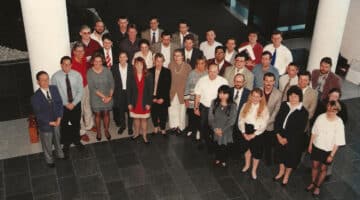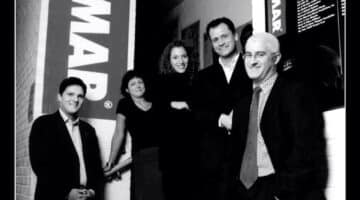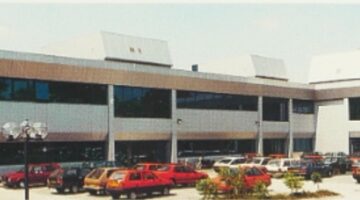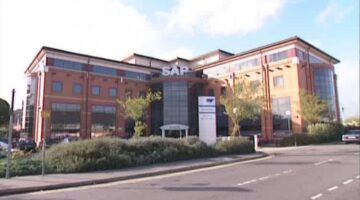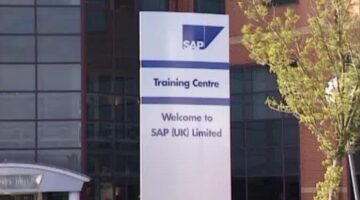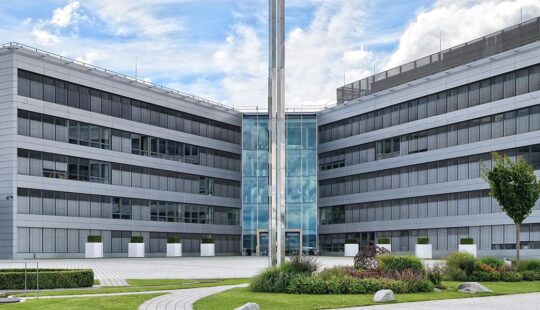In the 1990s, SAP continued to fly high in the United Kingdom. The company faced many challenges — not least managing a burgeoning headcount. And although some employees took a career detour along the way, the majority navigated their way safely back to the SAP world again.
Yet another training course is abruptly interrupted. Why? On the nearby runway at Heathrow Airport, a Concorde is preparing for take-off. “From the windows of our training rooms, we had a clear view of Concorde taking off,” says Peter Hunt. “And it wasn’t just the tremendous noise that caused the training sessions to be paused for several minutes at a time; basically, we all just wanted to witness this magnificent event.” Hunt joined SAP as a consultant in 1995. Having previously worked at Siemens, he was initially unsure whether he had made the right decision moving from a large German company to a small German company. Now, following various jobs at other companies, he has returned to SAP for the third time and works in Strategic Partner Management.
But Hunt’s story is not unique: It was said that when people left, many of them got their trouser braces caught in the door and were pulled back to SAP again.
Peter Hunt is still proud today of SAP’s triumphant rise in the United Kingdom following the introduction of SAP R/3 and the part he played in that success.
And speaking of reaching new heights, SAP’s rapid growth meant that, in 1995, another move became inevitable. And so it was that in May of the same year, SAP UK relocated from Weybridge to Feltham, a large town in West London. “We used to joke that locations were chosen based on how difficult they were for German-speakers to pronounce,” recalls Russell Thomas, who at the time was based in Walldorf working on UK payroll.
At first, the subsidiary set up its offices in an impressive new building in New Square at Bedfont Lakes, close to Heathrow Airport, where IBM had already taken up residence. A few years later, the New Square building parking garage was used as a set in the James Bond movie “Tomorrow Never Dies.” Looking back, its location near the airport seems symbolic of SAP UK’s success story even now. “SAP’s decision not to follow in the footsteps of many other tech companies and set up its offices in the Thames Valley along the M4 corridor that runs from Reading to Swindon was a pragmatic one, taken to make the journey to the subsidiary easier for senior managers flying in from Germany,” says Michael Longden, who joined SAP from one of its customers in 1992.
A Growing Need for Training
The Bedfont Lakes location offered other benefits too: Kyla Fox, who has been working as a management assistant at SAP for 28 years, remembers going for lunch at the IBM cafeteria, which served excellent food. “We simply swiped our cards and sauntered in past all the IBM employees lined up to pay for their food. SAP has always had a culture of providing free meals for employees.” And across the other side of the airport, at the Nobel Drive Training Centre on Bath Road, alongside the runway, SAP found sufficient space to meet its growing training needs. Alongside the center in Walldorf, it was one of the company’s largest training facilities at the time, with courses being held over four floors.
“Held in English, the courses attracted many participants from outside the UK too. As Head of Training, Jeremy White really had his hands full,” says Michael Longden.
“We were in the same boat as our customers,” recalls Peter Hunt. “A lot of the software, the help screens, and the documentation were still in German; and we were really also trying to convince ourselves when we asked our customers to trust us that there would be an English version soon.”
To meet the increased demand for consulting, SAP set up a consulting academy at the Training Center in 1995. The plan was for a further 500 R/3 specialists every year to join the ranks of the nearly 1,000 consultants already helping customers implement SAP’s new ERP system.
The demand for support too, was keeping pace. In 1993, the designated support hotline set up two years previously for SAP customers in the United Kingdom, for whom an SAP information database was also available, was expanded to create the Customer Support Group UK, headed up by Terrie Creswell until 1999. She had joined SAP in 1991, when R/2 was still the active product and when the way for R/3 was just about to be prepared. “I had started out in Training and spent a lot of time talking to our customers. So I knew that they were frustrated and wanted local support to meet the needs that centralized support in Walldorf couldn’t,” Terrie Creswell recalls. Ultimately, managing director Petra Frenzel tasked her with establishing a support group in London. “And so I was involved in setting up the global 24/7 customer service network. Working closely with colleagues around the world, we wrote the white paper that laid the groundwork for the future Customer Competence Centers.”
Close Ties with Headquarters
While SAP UK continued to expand at every level, construction of an imposing new office building began right next to the company’s headquarters in 1997. “Whenever we drove past the huge building site, we thought how great it would be if this were to become the new home of SAP UK,” recalls Peter Hunt.
The company was occupying more and more of the IBM building and it was clear that a larger headquarters was needed. Petra Frenzel and her leadership team were able to convince Executive Board member Henning Kagermann to acquire the new building. In the meantime, responsibility for SAP UK had been handed back from SAP International to SAP AG in Walldorf. “With Clockhouse Place, we had our own landmark building – visible both from the air and the road,” says Martin Metcalf, who was then part of the management team and would later become managing director of SAP UK.
Just as SAP UK’s management team were in frequent contact with the senior management in Germany, employees in the UK valued having a close relationship with SAP headquarters too. Sam Karbani, who joined SAP in 1996 and today works in Globalization Services, recalls her first trip to Walldorf, “Whenever anyone went to Germany for the first time, we’d tell them to ‘touch the ball.’” Touching the rotating basalt sphere in the foyer at SAP headquarters became a symbol for bonding with the parent company. “It was great to be able to work with the developers in Walldorf. I struggled a bit with the German cafeteria food, which back then was very meat-heavy, unlike in the UK, where there were already lots of vegetarians. But collaborating with our German colleagues was an experience I always relished.”
Fiona Walsh recalls how important it was, especially in Customer Support, to have a solid network in Walldorf: “That was the SAP spirit: learning and sharing your knowledge – and being generous with your time in that respect.” She joined SAP in 1992 and worked as an English-language assistant to SAP Executive Board Members Hans Schlegel and Klaus Tschira. “The EVZ, or WDF01 as it is now known, with its exclusive customer center on the sixth floor, had just been built, and hanging in the foyer was the ‘R/3 clock,’ which counted down the days remaining until the launch of SAP R/3.”
Expansion to Ireland
Following the official opening of the SAP Service and Support Centre (Ireland), Ltd. (SSC Dublin) in early 1997 to create additional support capacity for SAP’s international SAP R/3 customer base, the next logical step was to establish a dedicated sales office for Ireland. Until then, SAP’s Irish business had been conducted by a small team of salespeople and consultants based in London. Now, the new support unit was to report to Executive Board member Gerd Oswald and the sales unit to SAP UK. Among the new employees in Ireland was Irish-born Fiona Walsh, who came highly recommended by co-founder Klaus Tschira. Having worked in Germany for six years, she then transferred to the new sales office at Dublin’s East Point Business Park, where she took on the role of customer support manager. “In those days, our Irish customers preferred to deal with Irish companies,” says Fiona Walsh. “Over the next few years, SAP gained traction unbelievably quickly in the Irish market.”
Among those invited to the opening of the Dublin sales office were SAP UK employees, “We celebrated the opening at the Clarence Hotel, a four-star establishment that had been bought and newly refurbished by U2 singer Bono and U2 guitarist The Edge, and opened in 1996,” recalls Michael Longden, who rejoined SAP in 2008 following an almost 10-year break and today works as an SAP S/4HANA expert in Public Cloud Presales.
A Change in Command
The success of SAP in the UK and Ireland could have been Petra Frenzel’s ticket to a more senior role. But ultimately, her priority was to reduce her professional commitments. As is so often the case, it was easier for her to do this by leaving the company. “Henning Kagermann placed a great deal of trust in me when he gave me the opportunity to take on the role of managing director of SAP UK,” she says. When Petra Frenzel returned to SAP eight years later, she did so because she believed that she could best show her gratitude by once again being a highly committed member of the company.
Kevin Gibson, who had joined SAP in 1991, took over from Petra Frenzel as managing director at the beginning of 1998. “Kevin was a great leader and it was exciting to be part of the Sales team at this time. There was a lot of work to do, but we were all so proud of our successes. There was a wonderful sense of teamwork,” recalls Katie Wall, who joined SAP in 1996 as an executive assistant.
Fourteen months later, Kevin Gibson was to leave SAP and join Ariba Technologies. SAP management in Walldorf appointed Erwin (Ernie) Gunst as his successor. “And so there was another change, from a UK-focused to a more internationally aligned leadership style,” recalls Andrew Lack, who has been with SAP since 1998 and now sells SAP solutions for the consumer products industry. “It must have been quite a balancing act, on the one hand trying to stay close to the UK marketplace and on the other hand bridging the cultural gap to Walldorf and the rest of the SAP world.” However, the focus of leadership changes was always on spreading experience across the globe “SAP sent brilliant people on international assignments to really make a difference around the world,” says Hakan Yuksel, who was CFO and COO of SAP UK & Ireland (UKI) when Erwin Gunst took over as managing director from Kevin Gibson in 1999.
Former Head of Training and Customer Service Director Jeremy White knows from experience that “SAP UK offered an entrepreneurial working environment for self-starters. But it wasn’t for everyone. For some, it gave them a feeling of autonomy, while others perhaps felt they were left to their own devices. You had all the necessary ingredients to advance your career – you just had to get started and make it happen. However, a logical consequence of this was also that people often moved on and furthered their careers elsewhere.” Generally, however, they stayed in the SAP fold. One such example is White himself, who left SAP in 1998, but still works in the SAP ecosystem today. Kevin Richardson, who joined SAP in 1994 and now works at SAP Australia puts it like this, “Sometimes ex-colleagues of ours ended up spending more time with us at the office when they worked for partners than when they worked for SAP.”
Meanwhile, there were 6,000 trained consultants in the UK and Ireland, of whom only five percent were SAP employees, while the remaining 95% worked at partner companies. In 2001, around 1.6 million people on the British Isles were part of the SAP ecosystem. Fiona Walsh is glad she still works within SAP’s partner network, “The footprint SAP offers in the UK and Ireland has been really beneficial and a lot of people have made really good careers out of it. And this wonderful culture of partnership has been crucial to SAP’s success.”
No Growth Without Change
In 2000, SAP UK & Ireland achieved a growth rate of 40%, with business from the new “mySAP.com” solution accounting for half of that increase. Some 50% of the subsidiary’s revenues came from new customers, whose number rose to around 800. The millennium also saw Ernie Gunst replaced as managing director by Hans-Peter Klaey. “Hans-Peter came to meetings armed with his now legendary folder. He documented everything in that folder – down to the very last detail,” recalls Peter Robertshaw, who was marketing director at SAP UKI from 2000 until 2004. “That meant we had an accurate record of any objectives we discussed; it brought a new level of structure to our working practices.”
Under Klaey’s leadership, SAP UK became the principal sponsor of London’s Donmar Warehouse theater. As well as making a difference in the community, the company wanted to raise public awareness of the SAP brand in the United Kingdom. “The Donmar is a very avant-garde theater that attracts high-profile performers,” explains Melanie Waring, who joined SAP from Oracle in 2000 and has worked in various marketing and corporate marketing roles over the years.
In the early 2000s, many functions – marketing included – that had previously been the UK subsidiary’s own responsibility became part of group-wide structures. This shift was at odds with the tight-knit atmosphere that was characteristic of SAP UK in the early days and had fueled a strong sense of solidarity and friendship.
In September 2001, the world was turned upside down by the 9/11 terrorist attacks. “We’d all been at an offsite meeting in Windsor,” recalls Peter Robertshaw. “I remember seeing all the people in the pubs staring in shock at the TV.” Kevin Richardson was teaching at the Nobel Drive training centre and recalls how everyone stopped and gathered around the TV in the canteen. “Everyone will remember where they were on that day”, says Richardson. SAP provided financial support to those affected. Meanwhile, it urged its employees around the world to manage their costs carefully. Barely four years later, London itself became the victim of terrorist attacks.
Turbulence
At SAP UK, cost-saving measures led to lay-offs. With the subsidiary realigning its overall strategy to focus more on sales figures, employees who had not previously worked in sales bore the brunt of that shift. One of them was John Bannister, who, in 1988, had become SAP UK’s tenth employee. “I was laid off overnight – after almost 14 years. That really pulled the rug from under my feet.” Nevertheless, and perhaps surprisingly, Bannister is still in touch with numerous SAP alumni, follows SAP’s progress with keen interest, and enjoys reminiscing about his years at SAP. But: “However vital a realignment – and whatever the local notice periods are – there should be a rethink of the way in which employees are laid off, especially given the strong attachment they feel to SAP. Looking back, the nature of my departure from SAP is something neither I nor the company can be proud of,” he says.
At the beginning of 2002, Martin Metcalf was appointed managing director. He had previously served as sales director, then chief operating officer, and had been on the management team for seven years. At that time, despite all the difficulties the IT market faced, SAP was recognized as one of the top 15 employers in Britain.
Among SAP’s main competitors on the UK market was Oracle. “Back then, Oracle was the dominant supplier, particularly in the public sector, and it was initially difficult for us to gain a foothold,” says Martin Metcalf. The deal SAP signed in 2002 with the Inland Revenue – now called HMRC and responsible for assessing and collecting UK taxation – opened the door to this sector and was a landmark event in Metcalf’s eyes, not least because it shone a light on the expertise and support coming from management in Walldorf. “CEO Henning Kagermann flew over from Germany for the final stage of negotiations. He undertook to do everything in his power to meet the customer’s requirements in full, even though we couldn’t do that 100% at the time the deal was signed. We had an incredibly visionary product and – although we did of course face some huge challenges initially – customers believed in us.”
Fiona Walsh attributes SAP’s success in large part to the high level of investment in the industries. “At presentations, our presales people were always able to impress with their extensive knowledge, and they talked about the real problems plaguing customers in their respective industries. That made their audiences feel like they were in safe hands.”
Learning Processes and Management Styles
“Change is part of the natural evolution of a rapidly growing company,” says Martin Metcalf. SAP has been through all kinds of learning processes and different management styles and changes over the years, says Fiona Walsh. “But today’s whole movement into the cloud stems from the same ambition we had in the early days to help our customers be as successful as they can,” she adds.
For Martin Metcalf, who had been with the subsidiary in London since 1993 and accompanied its rapid growth for more than a decade, it was an honor being head of one of SAP’s leading subsidiaries and when he resigned from his post, which he held from 2002 to 2005, it was because he wanted to expand his leadership experience outside the SAP world. But he has long since returned to the SAP ecosystem and has fond memories of his career at SAP.
We heard similar stories from almost all of the 23 employees interviewed for this article. Many profess to having SAP “in their blood” or “in their DNA.” And while Concorde touched down at Heathrow Airport – just a stone’s throw from SAP UK’s offices – on its last ever landing on October 24, 2003, SAP continued to fly high, accompanied by an ever-expanding partner ecosystem in which many SAP alumni are still active.

